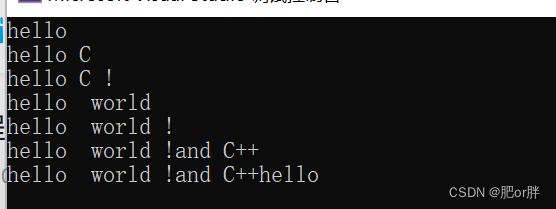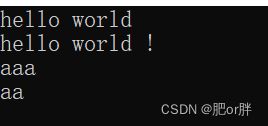C++STL中string详解(零基础/小白,字符串)
目录
1. 基本概念:
1.1 本质:
1.2 string和char*区别:
1.3 特点:
2. 构造函数(初始化)
3. 赋值操作
4. 字符串拼接
编辑
5 查找 和 替换
6. 字符串比较
编辑
7. 字符存取
8. 插入和删除
编辑
9. 子串获取
1. 基本概念:
1.1 本质:
string是C++风格的字符串,而string本质是一个类。
1.2 string和char*区别:
char* 是一个指针。
string是一个类,类内部封装了char*,管理这个字符串,是一个char*型的容器。
1.3 特点:
string类内部封装了很多成员方法。
例如:查找:find,拷贝copy,删除delete,替换replace,插入insert
string管理char*所分配的空间,不用担心赋值越界和取值越界的问题,有类内部负责。
2. 构造函数(初始化)
接下来都是先展示一下函数原型,具体如何操作将展示在代码中,如果看不懂函数原型,不要紧,直接看代码展示即可,学会怎么使用才是关键。当然要不需要去背,使用多了,自然记住了,并且记住的就是那些经常被使用的重要的。
初始化:
1. string(); //创建一个空的字符串
2. string(const char* s); //使用字符串s初始化
3. string(const sting& str); //使用一个string对象初始化另一个string对象
4. string(int n ,char c); //使用n个字符c初始化
// 第一种方法 创建空字符串
string s1;
//第二种 使用字符串s初始化string对象
const char* s = "hello world";
string s2(s);
cout << s2 << endl;
//第三种 使用一个string对象初始化另一string对象
string s3(s2);
cout << s3 << endl;
//第四种 将string初始化为n个字符c
string s4(10, 'a');
cout << s4 << endl;3. 赋值操作
赋值操作 : 给string字符串进行赋值
一类:
string& operator = (const char* s);
string& operatot = (const string& s);
sting& operator = (char c);
二类:string& assign(const string& s);
string& assign(const char* s);
string& assign(const char* s,int n);
string& assign(int n,char c);
//一类:
//1.1
string s1;
s1 = "hello";
cout << s1 << endl;
//1.2
string s2;
s2 = s1;
cout << s2 << endl;
//1.3
string s3;
s3 = 'c';
cout << s3 << endl;
//二类:
//2.1
string s4;
s4.assign(s1);
cout << s4 << endl;
//2.2
string s5;
s5.assign("hello");
cout << s5 << endl;
//2.3
string s6;
s6.assign("hello", 3);
cout << s6 << endl;
//2.4
string s7;
s7.assign(5, 'h');
cout << s7 << endl;其实初始化和赋值大部分都比较相似,熟悉了另一种就比较容易了。
对于是否要全部掌握,= 和 assign函数,其实并不需要担心,目前你先只要熟练掌握其中一种就好了。
4. 字符串拼接
拼接操作 : 实现在字符串末尾拼接字符串
一类:
string& operator += (const char* s);
string& operator += (const char c);
string& operator += (const string& str);
二类:
string& append(const char* s);
string& append(const char* s,int n);
string& append(const string& str);
string& append(const string& str,int pos,int n);
//第一类:
//1.1
string s1;
s1 += "hello ";
cout << s1 << endl;
//1.2
s1 += 'C';
cout << s1 << endl;
//1.3
string s2 = " !";
s1 += s2;
cout << s1 << endl;
//第二类:
//2.1
string s3 = "hello ";
s3.append("world");
cout << s3 << endl;
//2.2
s3.append(s2);
cout << s3 << endl;
//2.3
s3.append("and C++", 7);
cout << s3 << endl;
//2.4
s3.append(s1, 0, 5);
cout << s3 << endl;5 查找 和 替换
查找:查找指定字符串是否存在
——find 和 rfind的区别 :find从左往右查找,rfind从右往左查
int find(const string& str,int pos); 查找str第一次出现的位置,从pos位置开始查找
int find(const char* s,int pos); 查找s第一次出现的位置,从pos位置开始查找
int find(const char* s,int pos,int n); 从pos位置查找s的前n个字符第一次位置
int find(const char c,int pos); 查找字符c第一次出现的位置,从pos位置开始替换:在指定的位置替换字符串
string& replace(int pos,int n,const string& str);
string& replace(int pos,int n,const char* s);
这里我们并不会对所有的接口函数进行实现,只要把最常用的和一些需要注意的介绍一下,其他的留给你自己来实验。
1. find查找字符或字符串:
如果想从0位置开始,即pos=0,是可以省略的。
string str = "hello"
int pos1 = str.find("hel");
int pos2 = str.find('o');2. find从pos位置开始查找s的前n个字符出现的第一个位置
string str("hello string !");
int pos1 = str.find("strnig",0,3);
int pos2 = str.find("strnig",0,6);
cout<这里pos1为s的位置,而pos2为-1,因为str中没有strnig这个字符串,其中根本原因是n的不用,strnig这个字符串只有前3个字符出现在str中。
3. replace替换字符串
string str1 = "hello world";
str1.replace(6,3,"C++");
string str2 = "hello world";
str2.replace(6,5,"C++");
这里替换就是将前n个元素替换成新的字符串,新的字符串不受n的影响,n只影响被替换的字符个数。当n=0时,在pos位置插入。
6. 字符串比较
比较方式:字符串比较是按字符的ASCII码进行对比
= 返回 0
> 返回 1
< 返回 -1
int compare(const string& str) ;
int compare(const char* s);
string str1 = "hello";
string str2 = "world";
int com1 = str2.compare(str1);
cout << com1 << endl;
int com2 = str1.compare(str2);
cout << com2 << endl;7. 字符存取
string中单个字符存取方式有两种:
char& operator[](int n); //通过[]防水取字符
char& at(int n); //通过at方法获取字符
string str = "hello";
str[0] = 'w';
cout << str << endl;
str.at(0) = 'h';
cout << str << endl;8. 插入和删除
插入:
string& insert(int pos,const char* s); //插入字符串
string& insert(int pos,const string& str); //插入字符串
string& insert(int pos,int n,char c); //在指定位置插入n个字符c删除:
string& erase(int pos,int n) //删除从pos位置开始的n个字符
string str1 = "hello ";
str1.insert(6, "world");
cout << str1 << endl;
string str2 = " !";
str2.insert(0, str1);
cout << str2 << endl;
string str3;
str3.insert(0,3, 'a');
cout << str3 << endl;
str3.erase(0, 1);
cout << str3 << endl;9. 子串获取
从字符串中获取想要的子串
string substr(int pos,int n); //返回由pos开始的n个字符组成的字符串
string str = "abcdef";
string substr = str.substr(1, 3);
cout << "substr = " << substr << endl;




